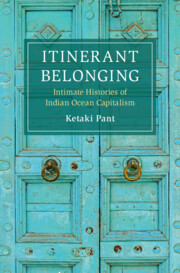Book contents
- Itinerant Belonging
- Cambridge Oceanic Histories
- Itinerant Belonging
- Copyright page
- Dedication
- Contents
- Figures and Maps
- Acknowledgments
- Note on Translation, Transliteration, and Place Names
- Note on Sources
- Prologue
- Introduction
- 1 Inhabited Histories
- 2 Haunted Houses
- 3 Unsettling Foundations
- 4 A House on a Hill
- Epilogue
- Notes
- Bibliography
- Index
1 - Inhabited Histories
Published online by Cambridge University Press: 10 April 2025
- Itinerant Belonging
- Cambridge Oceanic Histories
- Itinerant Belonging
- Copyright page
- Dedication
- Contents
- Figures and Maps
- Acknowledgments
- Note on Translation, Transliteration, and Place Names
- Note on Sources
- Prologue
- Introduction
- 1 Inhabited Histories
- 2 Haunted Houses
- 3 Unsettling Foundations
- 4 A House on a Hill
- Epilogue
- Notes
- Bibliography
- Index
Summary
This chapter explores the merchant houses of the port city of Rander, which were built by families involved in major colonial enterprises from cotton to shipping, to sugar and oil production, across an Indian Ocean geography from Durban to Rangoon. The continued attachment of these families to the old port, despite their residence in places across the Indian Ocean, suggests the significance of domestic space to wider colonial economic markets, ideas of family, and historic belonging in Gujarat. The chapter centers themes of travel, work, friendship, loss, celebration, and dwelling, as well as the impact of the 1857 rebellion and Muslim reformist movements on the built space of the port. The chapter also engages with contemporary merchant families and their relationships to their homes as sites of Indian Ocean pasts. In exploring the port’s homes and the itineraries that they orient, the chapter presents a nuanced interpretation of how the past is inhabited by port residents and the histories preserved through their efforts.
- Type
- Chapter
- Information
- Itinerant BelongingIntimate Histories of Indian Ocean Capitalism, pp. 36 - 74Publisher: Cambridge University PressPrint publication year: 2025

